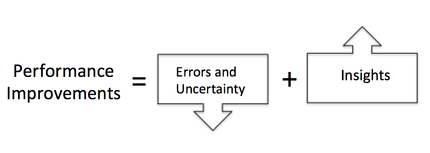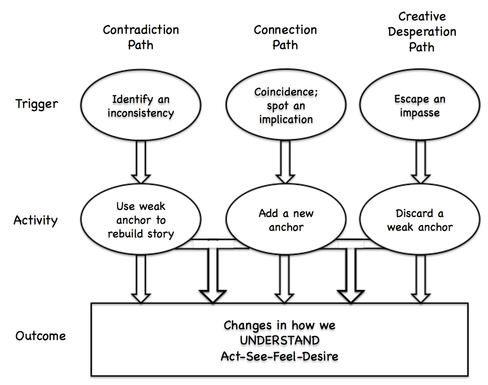 At some point we have each hopefully experienced an insight, that “aha” moment when a key piece to a puzzle, problem, or question comes to mind, providing us with a valued flash of brilliance. Because experiencing an insight is typically helpful, most of us would like to know how we gain insights and is there anything we can do to get more of them? For possible answers, we take a quick look at a book recently published in 2013 by research psychologist Gary Klein, Seeing What Others Don’t: The Remarkable Ways We Gain Insights. In the book, Klein presents an increase of insights as one part of the equation to improving our performance, while another component is the reduction of errors and uncertainty. Triple Path Model While it is performance improvement that appears to be the ultimate goal, the primary focus is the use of a Triple Path Model for gaining insight, which Klein created based on a two-person inter-rated review of 120 case studies. The model discusses contradictions, connections, and creative desperation each as a separate path to gaining insight, changing our current understanding of a particular issue or problem. Each path has a different trigger leading us to changes in our beliefs, which Klein calls “anchors”, identified as residing on a continuum from weak to strong. With a contradiction, the individual identifies an inconsistency with what they believe to be true, an anchor. One case was a young police officer that spotted a driver flicking ash from a cigarette onto the upholstery of a brand new BMW. This challenged the officer’s anchor regarding behavior of drivers of a new vehicle so the story had to be rebuilt. This required the officer to take the existing belief and rework it in an attempt to develop a plausible reason why a driver of a new BMW would intentionally flick ash onto the seat. This insight led to a pursuit and subsequent arrest of a car burglar.
Different than a contradiction, the connection path is triggered when a coincidence leads to developing a new anchor. This was the case when Dr. Michael Gottlieb made the connection between two unrelated patients suffering from similar symptoms. He noticed a coincidence that the two men were also gay. This led Gottlieb to create a new anchor to explore and upon verification resulted in the discovery of acquired immune deficiency syndrome (AIDS). The final path Klein discovered was one of creative desperation. Cases of creative desperation described in the book were marked by some impasse, usually under time pressure with severe if not fatal consequences. When Wagner Dodge, a smokejumper, found himself along with fifteen others on the side of a steep hill being pursued by a wall of fire quickly moving up the hill, he saved his own life by lighting the brush around him. Upon seeing the fire approaching, all of the smokejumpers began to move up the hill as quickly as possible to the safety on the other side, but the fire was too fast. In less than fifteen minutes, twelve of the smokejumpers were dead, two sought protection in rock outcroppings, and then there was Dodge. Four beliefs anchored Dodge’s understanding; the uphill slope favoring the fire, the fire itself which was picking up speed, the belief safety could be found at the top of the ridge or a rocky area, and the heavy dry grass being the fuel the fire is devouring. In desperation, Dodge knows that he cannot alter the slope or the fire. Those are anchors he cannot change. He also determines he cannot make it to the outcropping before the fire reaches him. The only anchor he can attack is the fuel being used by the fire. Dodge stops running and lights a fire. He then wet his handkerchief, put it over his mouth and lays in the ashes, hoping the fire will pass around him. Dodge saw what others did not. In the moment he had an insight and created a new tactic. As recounted by the other two survivors they did not understand what Dodge was doing, “We thought he must have gone nuts.” While there are three distinct paths presented in the model, this does not mean in real life there is no overlap. Near the bottom of the model arrows demonstrate that dependent on the situation a person may be on multiple paths at the same time. This was clearly demonstrated among the 120 cases reviewed by Klein, in that most cases had features of more than one path. Using the Model While obviously we don’t want to put ourselves in dangerous situations in order to travel down the path of creative desperation, what are some ways we can use the Triple Path Model to help gain insights? According to Klein, one way is to be more self-aware and be open to exploring contradictions instead of discarding them. Usually when we experience a contradiction we feel uncomfortable, we have a ‘tilt’ reflex. Because we don’t enjoy discomfort, most of us look at the contradiction as most likely a one-time occurrence, a random act that can be explained away. Instead, Klein encourages us to keep an open mind and explore the contradiction. When it comes to connection insights, the key is to continuously seek out knowledge and experiences in a variety of settings. Connection insights depend on having lots of different ideas and concepts bouncing around affording the opportunity for accidental linkages. A person who follows the same routine each and every day, participates in the same groups and activities and never is exposed to anything new will find it unlikely to experience a connection insight very often. The path of creative desperation is based on the concept that at least one of our assumptions is unwarranted. By discarding the flawed assumption we gain insights, a new understanding. Klein warns against the popular practice of analyzing an exhaustive list of assumptions, the rational choice model, and instead endorses the development of critical thinking skills. Critical thinking targets specific claims, core concepts that we need to review in determining their validity. Under pressure Dodge did not have time to mentally compile a list and analyze every possible anchor, it was a process of recognizing the weak anchor amongst his core beliefs. Moving Forward Probably one of the best features of Klein’s book is his very open admission regarding the limitations of his research. Klein acknowledges the book is simply an exploration, challenging the theory of insight proposed by the British social psychologist Graham Wallace back in 1926. Graham presented a four-stage model suggesting insights required preparation, incubation, illumination and verification. To this day the model is popular, but amongst the 120 case studies, Klein provides many examples where insights were gained without preparation or incubation. When Dodge found himself confronted by a wall of flame, there was no time for incubation. Moving forward Klein challenges us to build from his work. Going back to the beginning of this article on how to improve performance, Klein acknowledges it is probably not realistic to get organizations to embrace the pursuit of insight at the expense of uncertainty. Therefore, the weak anchor to attack is the right side of the equation, putting our efforts into developing a better understanding of insights, how we gain them and how we can use them to our advantage. After nearly 90 years of the four-stage model, Klein’s Triple Path Model is a good start. Article by Richard Feenstra, Ph.D. [email protected] _________________________________________________________________________________ References: Klein, G. (2013). Seeing what others don't: The remarkable way we gain insights. New York, NY, USA: PublicAffairs.
2 Comments
Rob Hutton
1/26/2017 09:05:51 am
Very nice summary of the book. I think that collaborative working where diverse perspectives are invited and challenged can also prompt some of the inferences and insights generated on the "Connection Pathway" approach to developing insights. Contrary to the warnings against "group think", group think structured in appropriate ways can benefit decision making. We are currently doing some research in this area. Happy to make connections if anyone has any thoughts on the role of collaboration in insight generation!
Reply
1/26/2017 09:29:48 am
Hi Rob, I wonder if this might be a happy coincidence? I recently answered a question on Quora about "group think." It discusses the benefits of "group think," and includes an article you might find useful in your research.
Reply
Your comment will be posted after it is approved.
Leave a Reply. |
Authors
Richard Feenstra is an educational psychologist, with a focus on judgment and decision making.
(read more) 
Bobby Hoffman is the author of "Hack Your Motivation" and a professor of educational psychology at the University of Central Florida.
(read more) Archives
April 2023
Categories |


 RSS Feed
RSS Feed
